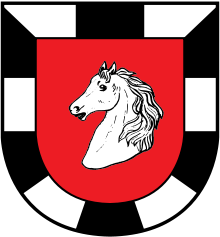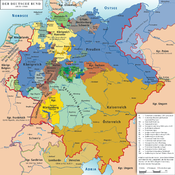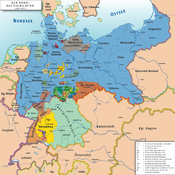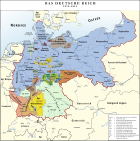- Saxe-Lauenburg
-
Duchy of Saxe-Lauenburg
Herzogtum Sachsen-LauenburgState of the Holy Roman Empire
State of the German Confederation← 
1296–1803
1814–1876 →
→
 →
→

Flag Coat of arms
as used 1507–1671Saxe-Lauenburg in 1848 (map in Dutch) Capital Lauenburg on Elbe (to 1619)
Ratzeburg (from 1619)Government Absolute monarchy Historical era Middle Ages - Partitioned from
Duchy of Saxony
1296- Partitioned into
Saxe-Mölln-Bergedorf
and Saxe-Ratzeburg
1303–1401- Personal union:
- with Lüneburg-Celle
- with Elect. Hanover
1689–1705
1705–1803- Dissolved during
Napoleonic Wars
1803–1814- Personal union:
- with Denmark
- with Prussia
1814–1864
1865–1876- Merged into Prussia 1876 The Duchy of Saxe-Lauenburg (German: Herzogtum Sachsen-Lauenburg, called Niedersachsen (Lower Saxony) between the 14th and 17th centuries), later also known as the Duchy of Lauenburg, was a reichsfrei duchy that existed 1296–1803 and 1814–1876 in the extreme southeast region of what is now Schleswig-Holstein. Its territorial center was in the modern district of Herzogtum Lauenburg and originally its eponymous capital was Lauenburg upon Elbe, though in 1619 the capital moved to Ratzeburg.
Contents
- 1 Former territories not part of today's district of Lauenburg
- 2 History
- 3 Dukes of Saxe-Lauenburg
- 4 External links
- 5 Notes
Former territories not part of today's district of Lauenburg
In addition to the core territories in the modern district of Lauenburg, at times other territories mostly south of the river Elbe belonged to the duchy:
- The tract of land along the southern Elbe bank (German: Marschvogtei), reaching from Marschacht to the Amt Neuhaus, territorially connecting the core of the duchy with these more southeastern Lauenburgian areas, ceded to the Kingdom of Hanover in 1814, now part of the Lower Saxon Harburg (district).
- The Amt Neuhaus proper, then including areas on both sides of the Elbe, ceded to the Kingdom of Hanover in 1814, all part of today's Lower Saxon Lüneburg (district)
- The exclave Land of Hadeln in the area of the Elbe estuary was disentangled from Saxe-Lauenburg in 1689 and administered as a separate territory under imperial custody, before its was ceded to Bremen-Verden in 1731, now its is part of today's Lower Saxon Cuxhaven (district).
- Some North Elbian municipalities of the former core duchy are not part of today's district of Lauenburg, since they had been ceded to the then Soviet occupation zone by the Barber Lyashchenko Agreement in November 1945.
History
 The coat of arms of Saxe-Lauenburg as fixed by Duke Julius Francis and confirmed by Leopold I, Holy Roman Emperor, in 1671. It shows in the upper left quarter the Ascanian barry of ten, in sable and Or, covered by a crancelin of rhombs (they are not shown in this undetailed copy) bendwise in vert.[1] The second quarter shows in azure an eagle crowned in or (crown missing in this copy). The third quarter displays in argent three water lily leaves in gules. The lower right fourth quarter shows in sable and argent the electoral swords (German: Kurschwerter) in gules, indicating the Saxon office as Imperial Arch-Marshal (German: Erzmarschall, Latin: Archimarescallus), pertaining to Saxon privilege as Prince-elector, besides the right to elect the new emperor after the decease of the former. Saxe-Lauenburg always claimed the privilege, but could not prevail after 1356.
The coat of arms of Saxe-Lauenburg as fixed by Duke Julius Francis and confirmed by Leopold I, Holy Roman Emperor, in 1671. It shows in the upper left quarter the Ascanian barry of ten, in sable and Or, covered by a crancelin of rhombs (they are not shown in this undetailed copy) bendwise in vert.[1] The second quarter shows in azure an eagle crowned in or (crown missing in this copy). The third quarter displays in argent three water lily leaves in gules. The lower right fourth quarter shows in sable and argent the electoral swords (German: Kurschwerter) in gules, indicating the Saxon office as Imperial Arch-Marshal (German: Erzmarschall, Latin: Archimarescallus), pertaining to Saxon privilege as Prince-elector, besides the right to elect the new emperor after the decease of the former. Saxe-Lauenburg always claimed the privilege, but could not prevail after 1356.
The duchy was established by partitioning the Duchy of Saxony into the duchies of Saxe-Lauenburg and Saxe-Wittenberg. The residences of Saxe-Lauenburg's dukes were located in the towns of Ratzeburg and Lauenburg/Elbe. The dukes of Lauenburg and Wittenberg each claimed the electoral dignity for their Duchy of Saxony.
In 1314 the dispute escalated into the election of two hostile German kings, the Habsburg Frederick III, the Fair, and his Wittelsbach cousin Louis IV, the Bavarian. Louis received five of the seven votes, to wit Archbishop-Elector Baldwin of Trier, the legitimate King-Elector John of Bohemia, Duke John II of Saxe-Lauenburg using his claim as the Saxon prince-elector, Archbishop-Elector Peter of Mainz, and Prince-Elector Waldemar of Brandenburg.
Frederick the Fair received in the same election four of the seven votes, with the deposed King-Elector Henry of Bohemia, illegitimately assuming electoral power, Archbishop-Elector Henry II of Cologne, Louis's brother Prince-Elector Rudolph I of the Electoral Palatinate, and Duke Rudolph I of Saxe-Wittenberg, rivallingly claiming the Saxon prince-electoral power. However, only Louis the Bavarian finally asserted himself as emperor of the Holy Roman Empire. The Golden Bull of 1356, however, conclusively named the dukes of Saxe-Wittenberg as electors.
From the 14th century, Saxe-Lauenburg termed itself as Lower Saxony (German: Niedersachsen).[2] However, Saxony as a naming for the area comprising the older Duchy of Saxony in its borders before 1180 still prevailed. So when in 1500 the Holy Roman Empire established the Imperial Circles as tax levying and army recruitment districts, the circle comprising Saxe-Lauenburg and all its neighbours became designated as Saxon Circle, while the Wettin-ruled Saxon electorate and duchies at that time formed the Upper Saxon Circle. The naming of Lower Saxony became more colloquial and the Saxon Circle was later renamed into Lower Saxon Circle. In 1659 Duke Julius Henry decreed in his general disposition (guidelines for his government) "to also esteem the woodlands as heart and dwell [of revenues] of the Principality of Lower Saxony."[3]
With the death of Duke Julius Francis the Lauenburg line of the House of Ascania became extinct in the male line. However, female succession was possible by the Saxe-Lauenburgian laws. So the two surviving out of the three daughters of Julius Francis, Anna Maria Franziska of Saxe-Lauenburg and Sibylle Auguste of Saxe-Lauenburg fought for the succession of the former, the elder sister. Their weakness was abused by Duke George William of the neighbouring Brunswick-Lüneburg principality of Lüneburg-Celle, who invaded Saxe-Lauenburg with his troops, thus inhibiting the ascension of the legal heiress to the throne Duchess Anna Maria.
Also other monarchies claimed the succession, resulting into a conflict involving further the neighbouring duchies of Mecklenburg-Schwerin and of Danish Holstein, as well as the five Ascanian-ruled Principalities of Anhalt, the Electorate of Saxony, which had succeeded the Saxe-Wittenbergian Ascanians in 1422, Sweden and Brandenburg. Militarily engaged were Celle and Danish Holstein, which agreed on 9 October 1693 (Hamburger Vergleich), that Celle anyway de facto holding most of Saxe-Lauenburg would retain the duchy, while the fortress in Ratzeburg, fortified under Celle rule and directed against Holstein, would be razed. In return Danish Holstein, which had invaded Ratzeburg and ruined the fortress, would withdraw its troops.
So Saxe-Lauenburg, except for Hadeln, passed to the House of Welf and its cadet branch House of Hanover, while the legal heirs, Anna Maria Franziska of Saxe-Lauenburg and Sibylle Auguste of Saxe-Lauenburg, never waiving their claim, were dispossessed and the former exiled in Bohemian Ploskovice. Emperor Leopold I rejected Celle's succession and thus retained Hadeln, which was out of Celle's reach, in his custody. Only in 1728 his son Emperor Charles VI enfeoffed George II Augustus with Saxe-Lauenburg, finally legitimising the de facto takeover by his grandfather in 1689 and 1693.
 Saxe-Lauenburg's coat of arms after 1864. These arms alter the Danish version, then featuring a golden horse head on red. Prussia added a bordure gyronny in black and white, its official colours, and showed the horse head in silver.
Saxe-Lauenburg's coat of arms after 1864. These arms alter the Danish version, then featuring a golden horse head on red. Prussia added a bordure gyronny in black and white, its official colours, and showed the horse head in silver.
The duchy was occupied by French troops in 1803–05, after which the French occupational troops left in a campaign against Austria. Then British, Swedish and Russian coalition forces captured Saxe-Lauenburg in autumn 1805 at the beginning of the War of the Third Coalition against France (1805–06). In December the Empire of the French, since 1804 France's new form of government, ceded Saxe-Lauenburg, which it no longer held, to Brandenburg-Prussia, which captured it early in 1806.
But when the Kingdom of Prussia (the name element Electorate of Brandenburg had turned void at the dissolution of the Holy Roman Empire on 6 August 1806), after it had turned – as part of the Fourth Coalition – against France, was defeated in the Battle of Jena-Auerstedt (November 11, 1806), France recaptured Saxe-Lauenburg. In remained first under French occupation, before on 1 March 1810 most of it was annexed to the Kingdom of Westphalia, a French client state. A small area with 15,000 inhabitants remained reserved for Napoléon's purposes. On 1 January 1811, most of the former duchy – except for the Amt Neuhaus and the Marschvogtei, which remained with Westphalia – was annexed to the First French Empire.
After the Napoleonic Wars, Saxe-Lauenburg was restored as a Hanoverian dominium in 1813. The Congress of Vienna established Saxe-Lauenburg as a member state of the German Confederation. In 1814 the Kingdom of Hanover bartered Saxe-Lauenburg against royally Prussian East Frisia. On 7 June 1815, after 14 months under its rule, Prussia granted Saxe-Lauenburg to Sweden, receiving in return prior Swedish Pomerania, however, additionally paying 2.6 million Taler to Denmark, in order to compensate Danish claims to Pomerania.[4] Denmark gained that ducal territory north of the Elbe, now ruled in personal union by the Danish House of Oldenburg, from Sweden, which thus again compensated Danish claims to Swedish Pomerania.
In 1864, Prussia occupied the duchy during the Second Schleswig War. In 1865 Saxe-Lauenburg's Estates of the Realm offered William I of Prussia to become Duke of Saxe-Lauenburg. He agreed and ruled the duchy in personal union. William appointed the then Minister President of Prussia, Otto von Bismarck, as minister for Saxe-Lauenburg. In 1867 Saxe-Lauenburg joined the North German Confederation.
In 1871 Saxe-Lauenburg was one of the component constituent states founding united Germany. However, in 1876 the ducal government and the estates decided to dissolve the Duchy effective 1 July 1876. Its territory was then integrated into the Prussian Province of Schleswig-Holstein as the district Herzogtum Lauenburg, meaning the Duchy of Lauenburg.
Dukes of Saxe-Lauenburg
For the Duchesses consort see List of Saxon consorts, partially also presenting portraits. For portraits of the dukes, starting with Julius Henry, see List of Saxon rulers.
House of Ascania (1296–1689)
Main article: House of AscaniaThe counting of the dukes includes the preceding Ascanian dukes Bernard I, his son Albert I, and the latter's jointly ruling sons John I and Albert II, all of which ruled the Saxon dukedom before its partition into Saxe-Lauenburg and Saxe-Wittenberg.
- Eric I 1296–1303 joint rule, then ruling until 1360 in Saxe-Bergedorf, partitioned from Saxe-Lauenburg (see #Ratzeburg-Lauenburg line below)
- John II 1296–1303 joint rule, then ruling until 1321 in Saxe-Ratzeburg, partitioned from Saxe-Lauenburg (see section #Bergedorf-Mölln line below)
- Albert III 1296–1303 joint rule, then ruling until 1308 in Saxe-Ratzeburg, partitioned from Saxe-Lauenburg, dying without issue Eric I inherited his share
In 1303 the brothers split their inheritance between them, however, only tow brothers had heirs creating the Bergedorf-Mölln and the Ratzeburg-Lauenburg lines.
Bergedorf-Mölln line
First named Saxe-Mölln, however, renamed following a territorial redeployment including parts of Albert III's share in 1321.
- 1303–22: John II (*ca. 1275–1322*), ruled alone in Bergedorf-Mölln, rivalled as Saxon Prince-Elector by his cousin Rudolph I of Saxe-Wittenberg in 1314
- 1322–43: Albrecht (Albert) IV (*?–1343*), son of the preceding.
- 1343–56: John III (*?–1356*), son of the preceding.
- 1356–70: Albrecht (Albert) V (*?–1370*), brother of the preceding.
- 1370–1401: Eric III (*?–1401*), brother of the preceding.
In 1401, the elder branch became extinct and Lauenburg rejoined the Ratzeburg-Lauenburg line.
Ratzeburg-Lauenburg line
First named Saxe-Bergedorf-Lauenburg, however, renamed following a territorial redeployment after inheriting Albert III's share.
- 1303–38: Eric I (*?–1360*), resigned in 1338.
- 1338–68: Eric II (*1318/1320–1368*), son of the preceding.
- 1368–1412: Eric IV (*1354–1411/1412*), son of the preceding, ruled jointly with his sons Eric V and Bernard II since 1401.[5]
In 1401, the younger branch inherited Lauenburg and other possessions of the extinct elder Bergedorf-Mölln line.
- 1401–36: Eric V (*?-1436*), son of the preceding, ruled jointly with his father until 1412, his brother John IV until 1414 and his younger brother Bernard II as of 1426.
- 1401–14: John IV (*?-1414*), brother of the preceding, ruled jointly with his father until 1412 and his brother Eric V.
- 1426–63: Bernard II (*1385/1392–1463*), brother of the preceding, ruled jointly with his brother Eric V as of 1426.[6]
- 1463–1507: John V (*1439–1507*), son of the preceding.[7]
- 1507–43: Magnus I (*1488–1543*), son of the preceding.
- 1543–71: Francis I (*1510–1581*), son of the preceding, resigned in favour of his son Magnus II.[8]
- 1571-74: Magnus II (*1543–1603*), son of the preceding.[9]
- 1574–81: Francis I (*1510–1581*), reascended the throne, replacing his son Magnus II.
- 1581-88: Magnus II (*1543–1603*), son of the preceding, ruled jointly with his brothers Maurice and Francis II, Magnus resigned in 1588.
- 1581-1612: Maurice (*1551–1612*), ruled jointly with his brothers Magnus II (till 1588) and Francis II.
- 1581–1619: Francis II (*1547–1619*), ruled jointly with his brothers Magnus II (till 1588) and Maurice (till 1612).[10]
- 1619–56: Augustus (*1577–1656*), son of the preceding.[11]
- 1656–65: Julius Henry (*1586–1665*), brother of the preceding.[12]
- 1665–66: Francis Erdmann (*1629–1666*), son of the preceding.
- 1666–89: Julius Francis (*1641–1689*), brother of the preceding.[13]
House of Welf (1689–1803)
Main article: House of WelfFor 113 years the duchy was ruled by members of the Welf dynasty. However, since its violent takeover only in 1728 Emperor Charles VI enfeoffed George II Augustus with Saxe-Lauenburg, finally legitimising the Welfs as dukes.
House of Brunswick and Lunenburg–Celle (1689–1705)
- 1689–1705: George William; also Prince of Brunswick and Lunenburg (Celle), by title also Duke of Brunswick and Lunenburg.
House of Hanover (1705–1803)
See also: House of Hanover- 1705–27: George I Louis; also Prince-Elector of Brunswick and Lunenburg (Calenberg) (commonly called Electorate of Hanover, after its capital), by title also Duke of Brunswick and Lunenburg; also King of Great Britain from 1714.
- 1727–60: George II Augustus; also King of Great Britain, Elector of Hanover, by title also Duke of Brunswick and Lunenburg.
- 1760–1814: George III, de facto dispossessed in 1803–05 and 1805–14, however he held up the title of duke, rejecting any unilateral act and annexation by Napoléon. Only at the Congress of Vienna, where all sides agreed, the title of duke passed to his nephew. Also King of Great Britain (becoming King of Great Britain and Ireland in 1801), Elector of Hanover (becoming King of Hanover in 1814), by title also Duke of Brunswick and Lunenburg.
Napoleonic Wars (1803–14)
See also: Napoleonic Wars- Occupied by the First French Republic, 1803–04.
- Occupied by the First French Empire, 1804–05.
- Recaptured by British, Swedish and Russian forces of the Third Coalition against France, 1805.
- Occupied by the Kingdom of Prussia, 1805–07.
- Occupied by the First French Empire, 1807.
- Annexed to the Kingdom of Westphalia, 1807–10.[citation needed]
- Annexed to the First French Empire, 1810–14.
House of Oldenburg (1814–64)
See also: House of OldenburgFor fifty years, from 1814, Saxe-Lauenburg was within the German Confederation, and in personal union with the Kingdom of Denmark:
Main line (1814–63)
- 1814–39: Frederick I; also King of Denmark (1808–39, as Frederick VI) and Duke of Schleswig-Holstein; previously King of (1808–14) and Regent of Denmark-Norway from 1784.
- 1839–48: Christian I; also King of Denmark (as Christian VIII) and Duke of Schleswig-Holstein; previously King of Norway (1814, as Christian Frederick).
- 1848–63: Frederick II; also King of Denmark (as Frederick VII) and Duke of Schleswig-Holstein.
Glücksburg line (1863–64)
See also: House of Glücksburg- 1863–64: Christian II; also King of Denmark (1863–1906, as Christian IX) and Duke of Schleswig-Holstein.
House of Hohenzollern (1865–76)
See also: House of HohenzollernFor twelve years Saxe-Lauenburg was ruled in personal union with Prussia, within the North German Confederation (1867–71). In 1871 Saxe-Lauenburg became a component state of united Germany (German Empire).
- 1865–76: William; also King of Prussia (1861–88), President of the North German Confederation (1867–71) and German Emperor (1871–88).
Dependent rule (1876–present)
- In 1876 the Duchy gave up statehood and was transformed into the District of the Duchy of Lauenburg within Schleswig-Holstein, a province of the Kingdom of Prussia (1866–1918) and then of the Free State of Prussia (1918–33/1947), a component state of the respective government forms of Germany. In 1946 the province assumed the rank of statehood as State (Land) of Schleswig-Holstein and joined the Federal Republic of Germany in 1949.
- In 1890, Imperial Chancellor Otto von Bismarck was awarded the honorific title of Duke of Lauenburg including estates in the Sachsenwald in the former duchy, but he was never sovereign ruler of the territory, which had been incorporated into Prussia in 1876. He moved to these estates in Friedrichsruh and lived there until his death.
External links
- Historical map of Schleswig Holstein in 1730
- Historical map of Lower Saxony in 1789
- Historical atlas of Saxe-Lauenburg
Notes
- ^ The House of Wettin also adopted this coat-of-arm, when it gained Saxe-Wittenberg, which is why they reappear in the arms of many (formerly) Wettin-ruled states.
- ^ However, today's State of Germany named Lower Saxony comprises only small fringes of Lauenburgian Lower Saxon territory, to wit: its areas south of the river Elbe, such as:
i) the Land of Hadeln
ii) a tract of land along the southern Elbe bank, connecting from Marschacht to the Amt Neuhaus
iii) the Amt Neuhaus. - ^ The addition in edged brackets not in the original. In the German original: "... auch die Höltzung für des Fürstenthumbs Niedersachsen Kern und Brunquell zu achten." Generaldisposition of Julius Francis, 1659.
- ^ Pommern, Werner Buchholz (ed.), Werner Conze, Hartmut Boockmann (contrib.), Berlin: Siedler, 1999, pp. 363 seq. ISBN 3-88680-272-8
- ^ His wife was Sophia of Brunswick and Lunenburg (Wolfenbüttel) and they had Catharina of Saxe-Lauenburg (mar. Henry IV, Duke of Mecklenburg-Schwerin) as daughter.
- ^ His wife was Adelheid of Pomerania and they had Sophie of Saxe-Lauenburg (*before 1428-1473*) as daughter, married to Gerhard VII, Duke of Juliers.
- ^ His wife was Dorothea of Brandenburg (c. 1446 – March 1519, daughter of Frederick II, Elector of Brandenburg). Their children were Eric of Saxe-Lauenburg (1472 - 20 October 1522, as Eric I Prince-Bishop of Münster, as II Prince-Bishop of Hildesheim) and Sophia of Saxe-Lauenburg (mar. in ca. 1420, d. 1462, mother of Eric II, Duke of Pomerania).
- ^ He married on 8 February 1540 Sybille of Saxe-Freiberg (Freiberg, 2 May 1515 - 18 July 1592, Buxtehude), daughter of Henry IV of Saxe-Wittenberg. Their children were Henry of Saxe-Lauenburg (as Henry II Prince-Bishop of Osnabrück, as III Prince-Archbishop of Bremen and as IV Prince-Bishop of Paderborn), Sidonia Katharina of Saxe-Lauenburg (mar. with Wenceslaus III Adam, Duke of Cieszyn) and Ursula of Saxe-Lauenburg-Ratzeburg (mar. with Henry, Duke of Brunswick and Lunenburg (Dannenberg)).
- ^ His wife was Sophia of Sweden.
- ^ Francis' wife was Mary of Brunswick and Lunenburg (Wolfenbüttel) (1566-1626, daughter of Julius, Duke of Brunswick and Lunenburg (Wolfenbüttel)) and they had daughters Juliane of Saxe-Lauenburg (26 December 1589 - 1 December 1630, mar. 1 August 1627), married to Friedrich, Duke of Schleswig-Holstein-Sonderburg-Norburg, and Sophie Hedwig of Saxe-Lauenburg (24 May 1601 - 1 February 1660, mar. 23 May 1624) with Philipp, Duke of Schleswig-Holstein-Sonderburg-Glücksburg.
- ^ His wife was Elisabeth Sophie of Holstein-Gottorp, daughter of John Adolf, Duke of Holstein-Gottorp. Their daughter was Anna-Elisabetha of Saxe-Lauenburg (23 August 1624 - 1688, mar. 2 April 1665), wife of William Christoph, Landgrave of Hesse-Homburg.
- ^ He married three times: 1) Anne of Ostfriesland, 2) on 27 February 1628 Elisabeth Sophia of Brandenburg (13 July 1589–24 December 1629), daughter of John George, Elector of Brandenburg and mother of Duke Francis Erdmann, and 3) on 18 August 1632 Anna Magdalene, Baroness Popel von Lobkowitz (d. 7 September 1668), the only to ascend with him to the throne on 18 January 1656. She was mother of Duke Julius Francis.
- ^ His wife was Hedwig of Palatine Sulzbach (15 April 1660 - 23 November 1681; daughter of Christian Augustus, Count Palatine of Sulzbach) and they had Anna Maria Franziska of Saxe-Lauenburg and Sibylle Auguste of Saxe-Lauenburg as daughters.
 Lower Saxon Circle (1500–1806) of the Holy Roman Empire
Lower Saxon Circle (1500–1806) of the Holy Roman EmpireEcclesiastical 
Secular Bremen (from 1648) · Brunswick (Blankenburg (until 1731) · Calenberg2 · Grubenhagen (until 1596) · Wolfenbüttel) · Hanover (from 1708) · Holstein (Glückstadt · Gottorp) · Lüneburg2 · Mecklenburg (Güstrow (until 1695) · Schwerin · Strelitz (from 1701)) · Rantzau (until 1734) · Regenstein · Saxe-Lauenburg2Cities 1 until 1648. 2 until 1705.  States of the German Confederation (1815–66)
States of the German Confederation (1815–66)Empires 
Kingdoms Electorates Grand Duchies Duchies Anhalt (Bernburg2 · Dessau2 · Köthen3) · Brunswick · Holstein · Limburg4 · Nassau · Saxe-Lauenburg · Saxony (Altenburg5 · Coburg-Saalfeld6 · Coburg-Gotha5 · Gotha-Altenburg6 · Hildburghausen6 · Meiningen)Principalities Hesse-Homburg · Hohenzollern (Hechingen7 · Sigmaringen7) · Liechtenstein · Lippe · Reuss (Elder · Junior) · Schaumburg-Lippe · Schwarzburg (Rudolstadt · Sondershausen) · Waldeck and PyrmontCity-states Other territories
outside of the
confederacyColonial possessions · Personal unions of Habsburg (Bukovina · Croatia · Galicia and Lodomeria · Hungary · Lombardy–Venetia · Serbian Voivodeship and Banat8 · Slavonia9 · Transylvania) · Personal union of Hanover (Great Britain and Ireland10) · Personal unions of Hohenzollern (East Prussia11 · Neuchâtel12 · Posen, Gr. Duchy13 · Posen, Prov.14 · Prussia, Prov.15 · West Prussia11) · Occupied: Schleswig161 w/o areas listed under other territories. 2 Merged with Anhalt from 1863. 3 until 1847. 4 from 1839. 5 from 1826. 6 until 1826. 7 until 1850. 8 1849–60. 9 as of 1849. 10 until 1837. 11 until 1829. 12 until 1848/57. 13 until 1848. 14 as of 1848. 15 as of 1829. 16 as of 1864.  States of the North German Confederation (1866–71)
States of the North German Confederation (1866–71)Kingdoms 
Grand Duchies Duchies Principalities Schaumburg-Lippe · Schwarzburg (Rudolstadt · Sondershausen) · Lippe · Reuss (Elder · Junior) · Waldeck-PyrmontCity-states  States of the German Empire (1871–1918)
States of the German Empire (1871–1918)Kingdoms 
Grand Duchies Duchies Anhalt · Brunswick · Saxe-Altenburg · Saxe-Coburg and Gotha · Saxe-Lauenburg (until 1876) · Saxe-MeiningenPrincipalities Schaumburg-Lippe · Schwarzburg-Rudolstadt · Schwarzburg-Sondershausen · Lippe · Reuss Elder Line · Reuss Junior Line · Waldeck-PyrmontCity-states Other territories Elsaß-Lothringen · Colonial possessionsCategories:- Former monarchies of Europe
- Former countries in Europe
- States of the Holy Roman Empire
- States and territories established in 1296
- States and territories disestablished in 1876
- 1876 disestablishments
- States of the German Confederation
- States of the German Empire
- House of Ascania
- History of Schleswig-Holstein
- Dukes of Saxe-Lauenburg
- Dukes of Germany
- Germany-related lists
Wikimedia Foundation. 2010.


